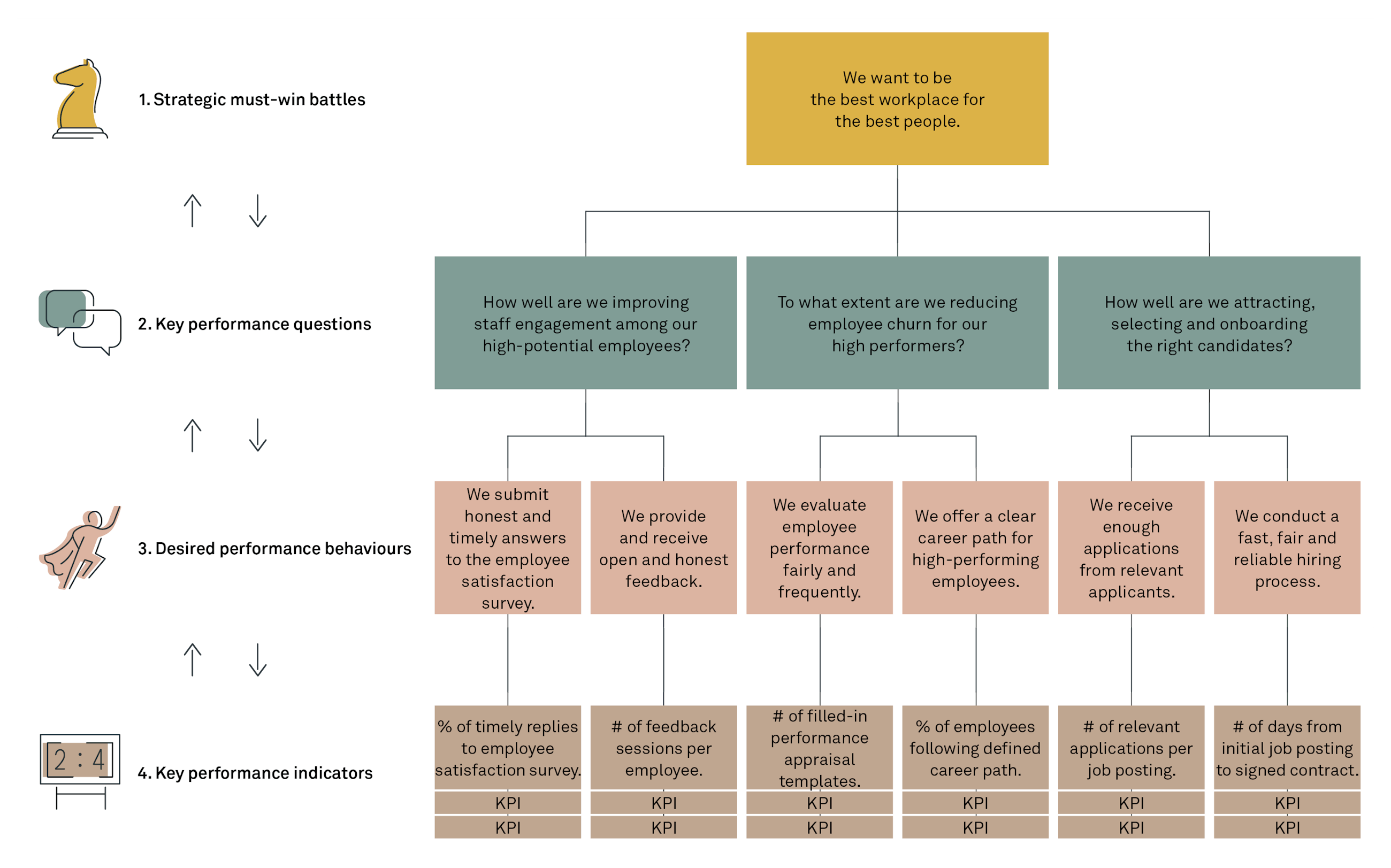Link your strategy to behavioural performance metrics in four steps
17 January 2023
A performance management system aligns an organisation’s efforts with its strategic objectives. However, implementing this strategy at the operational level can be difficult. A four-step process can aid in translating corporate strategy into actionable components for all employees to understand and work towards.
Describe the expected behaviour from people in your organisation
The four-step process follows a top-down approach, starting with the overall corporate strategy by formulating “must-win battles” and understanding the organisation’s direction. This is then used to develop “key performance questions” to identify what needs to be true for the organisation to achieve its objectives. “Desired performance behaviours” are then designed to answer these questions, and measures are finally defined to guide employees towards the desired performance and evaluate whether the behaviour is achieved.
Step 1: Strategic must-win battles
Definition: Must-win battles are the three to five challenges an organisation must conquer to achieve its key objectives.
The starting point of any proper performance management system should be the organisation’s corporate strategy and desired future state. Must-win battles are the top challenges your organisation must conquer to achieve its key objectives. They are defined by understanding the foundation of the corporate strategy and the role of the organisation and choosing and articulating a limited number of strategic priorities. With the must-win battles identified, the next step in the process can begin.
Step 2: Key performance questions
Definition: Key performance questions are open questions that highlight what an organisation needs to know in terms of executing its strategic objectives.
To make strategy work, we need to translate must-win battles into key performance questions. These questions should be precise, forward-looking and open-ended, focusing on how well the organisation is achieving its strategic objectives and encouraging exploration and elaboration. They should also start with “how well” or “to what extent” and not be yes/no questions, focusing on the present and future rather than the past. By regularly revisiting key performance questions, an organisation can better manage itself and work towards its strategic objectives.
“We run the company by questions, not by answers. So in the strategy process, we’ve so far formulated 30 questions that we have to answer (...) You ask it as a question rather than a pithy answer, and that stimulates conversation. Out of the conversation comes innovation.”
- Google CEO Eric Schmidt on the importance of asking questions
Step 3: Desired performance behaviours
Definition: Desired performance behaviours are the actions that are believed to support our ability to assess each of the key performance questions.
To effectively implement a strategy, it is important to identify the key performance questions that will guide organisational efforts and help achieve must-win battles. However, simply having a strategy is not enough. It must also be operationalised, meaning that there must be a change in behaviour to bring the strategy to life. One way to operationalise a strategy is to define specific performance behaviours that align with each key performance question. These behaviours should be observable, specific to a certain circumstance or group of employees and involve a choice. Hence, they should reflect a conscious decision to take a certain action or response instead of alternative behaviours. For example, if one of the must-win battles is to improve customer centricity, defining a behaviour such as “all employees speak politely to the customer in any situation” can help make this abstract goal more actionable and achievable.
Step 4: Key performance indicators
Definition: Key performance indicators are quantifiable metrics that reflect how well an organisation is achieving its strategic goals and objectives.
In the final step of operationalising a strategy, it is important to define key performance indicators (KPIs) that are related to each desired performance behaviour. These KPIs should be quantifiable and measurable metrics that show how well the desired performance behaviour is being exhibited in the organisation. It is generally more useful to focus on leading indicators, which predict future performance, rather than lagging indicators, which reflect patterns that have already taken place.
For example, if the desired performance behaviour is “all employees speak politely to the customer in any situation”, then a leading KPI might be “number of employees who received customer dialogue training” while a lagging KPI might be “number of customer complaints mentioning impolite talk”. By tracking changes in these metrics, it is possible to determine whether the desired performance behaviour is being sustained throughout the organisation.
In general, KPIs should be actionable and influenceable, meaning that employees should be able to understand how they can impact the metric. They should also be clearly defined, transparent, easily understood and should be objective rather than subjective or partisan. The final result of this process should be a clear and detailed breakdown of key performance questions, desired performance behaviours and KPIs for each must-win battle.
Final remarks
By following this process, you can define behavioural performance metrics that are aligned with your organisation’s strategic objectives. However, to ensure a comprehensive performance management system, it is advisable to supplement these behavioural performance indicators with metrics that are directly linked to the key performance questions. This will allow you to track not only the behaviours that are incentivised by the desired performance indicators but also the associated effects on operational performance, customer satisfaction and financial results.
In other words, you want to be able to track not only whether employees are doing the right thing but also how that behaviour is impacting the overall performance of the organisation.






